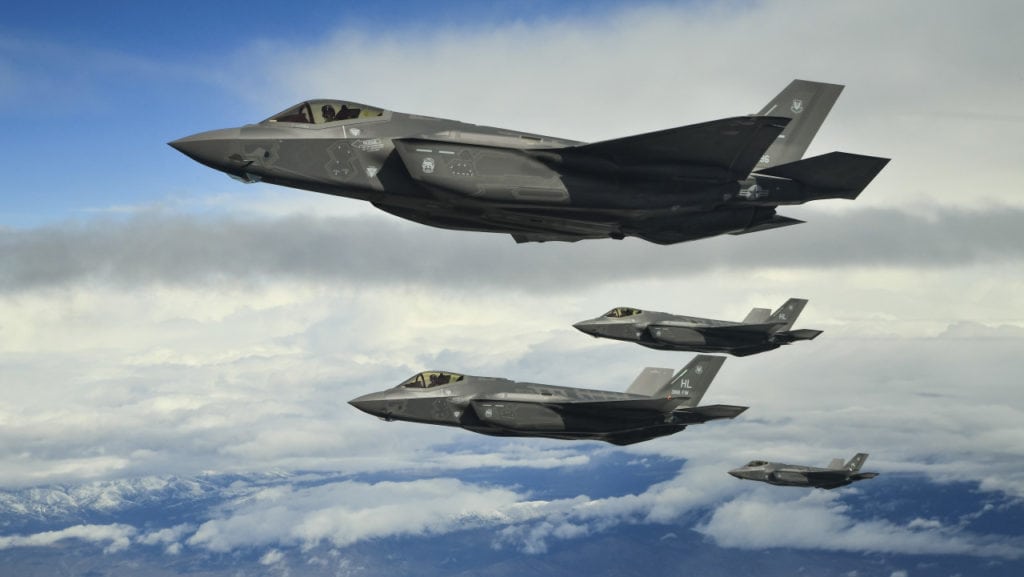GAO Finds Increased Delays and Costs for F-35’s Block 4 Modernization


A squadron of F-35As flying over Hill Air Force Base in Utah. (U.S. Air Force)
The Department of Defense (DoD) needs an updated modernization schedule and improved data on software development before the F-35 can transition from development to full production leaving the program with more timeline delays and costs, according to a new Government Accountability Office (GAO) report released on March 18.
The F-35 program is currently working on a modernization effort, known as Block 4, where the DoD is delivering capabilities to the warfighter by incrementally developing, testing, and delivering small groups of capabilities every six months, according to the report. This process referred to as C2D2 is based on the Agile software development process. However, the GAO says Block 4’s remaining development schedule is not attainable.

An updated timeline for F-35 operational test schedules through 2021. (GAO)
The DoD has been working on the Block 4 modernization for three years and continues to expand its timeline and budget.
“For example, in 2018, DOD reported that Block 4 development would cost $10.6 billion for fiscal years 2018 through 2024,” the report states. “As of September 2020, DOD reported to Congress that all Block 4 costs are expected to exceed $14 billion, spanning fiscal years 2013 through 2027.”
GAO’s team found the timeline estimations that were given were based on estimates formulated at the start of the effort and not according to the contractor’s demonstrated performance.
“This decision to change how costs are reported stems from DoD efforts to respond to our recommendation that it improve transparency into the total costs associated with Block 4 development,” the report states. “Specifically, in May 2020, we found that DoD’s Block 4 reports to Congress, required by Section 224 of the NDAA for Fiscal Year 2017, did not fully represent the total estimated costs of Block 4 development. DOD focused its reporting of Block 4 costs on the future year defense program and excluded previously incurred costs and any costs expected to be incurred after a 7- year period.”
The report found delays in the development of the F-35 Joint Simulation Environment, which runs the mission systems software and other software models, resulted in the program’s inability to complete 64 planned tests in 2020. These problems were identified in August 2020 and there is no current timeframe for a fix to the problems found.
The simulator delays, which have been further postponed full production from March of this year, are related to high overall open deficiencies, production delays and quality issues, efforts to address Turkey’s removal from the supply chain, and aircraft not meeting reliability and maintainability goals, according to the report.
Despite these problems, the program was able to complete four open-air tests at Point Mugu Sea Range, two of three missile tests, and operational cybersecurity testing, according to the report.
Technology Refresh 3 (TR-3), a suite of software and hardware technologies that provide updated processing capability, display units, and increased memory to the aircraft, is on track to be deployed into lot 15 aircraft in 2023, according to the report.
The report also found that the program’s Block 4 software development is not following leading practices. The report said Lockheed Martin does not have access to automated tools to capture real-time performance data to make its collected software development metrics helpful.
The program also needs performance targets for software metrics, the report found.
“While we recognize the challenges with transitioning to Agile development, after three years of effort the F-35 program continues to have issues with effectively implementing the C2D2 approach to develop and deliver Block 4 capabilities,” the report states. “The airframe contractor continues to deliver capabilities late, and the remaining schedule contains significant risk and is not achievable based on the pace of past performance. While the program office is committed to delivering capabilities more quickly to the warfighter, the program has not delivered on its initial iterative plan. Without an achievable schedule informed by historical performance, the program is likely to continue falling short of its expectations, and the warfighter will have to wait longer for the promised capabilities.”
Doug Birkey, executive director of the Mitchell Institute for Aerospace Studies, told Avionics International that many of the problems faced by the program such as the new issues addressed in this report are the cause of complexity and growing pains.
“It’s really, in many ways, the pathfinder for incredibly sophisticated sensor shooter type aircraft and by that I mean, the aircraft has onboard the sensors to gather immense amounts of data wherever it flies, process it onboard, and link to other aircraft to execute its mission and all of the requirements were created in the 90s. The initial kind of baseline was laid out in the 2000s,” Birkey said. “And so that was very advanced back then, and there’s a learning curve that comes along with it.”
Birkey said that while the progress of the program hasn’t always been ideal the aircraft is still ultimately important to U.S. defense.
“The bottom line takeaway on all this is that the country needs the aircraft,” Birkey said. “I mean, the capabilities it brings to the equation, which is really stealth, electronic warfare, and high degree situational awareness and the sensors and processing capability, those attributes are what you need to stay alive in the current environment, and on the fighter side it is the only thing we have in production, that does that.”
The post GAO Finds Increased Delays and Costs for F-35’s Block 4 Modernization appeared first on Aviation Today.
Check FastApn access for commercial satcoms at Fastapn
Flytlink – Avionics, Satcom’s and IFE Consultants






